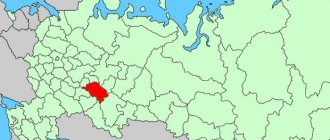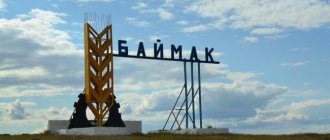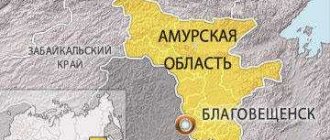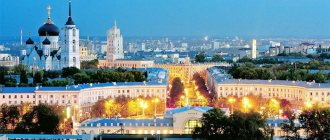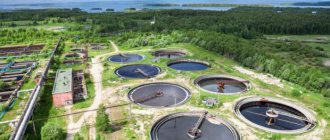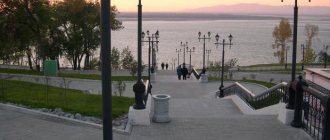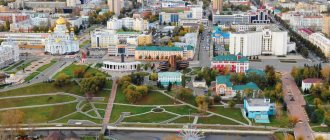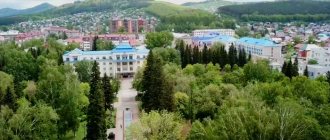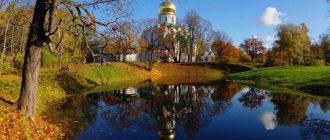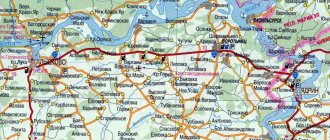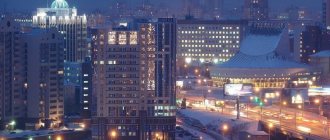Republic of Bashkortostan: cities and regions of the Republic of Bashkortostan, recreation, excursions, nature reserves, parks, museums, churches, attractions.
- Last minute tours
to Russia
The Republic of Bashkortostan is located in the southern part of the Ural Mountains, on the border of Europe and Asia. The republic received its name from the name of the indigenous Bashkir people (Bashkort), which, in turn, was formed from two words “bash” and “court”, which translated means “main bee”.
The territory of the republic is located in the basins of the Volga, Ural and Ob rivers. The capital of Bashkortostan is the city of Ufa with a population of more than one million people. Large cities: Sterlitamak, Salavat, Neftekamsk, Oktyabrsky, Beloretsk. Local time is 2 hours ahead of Moscow.
Story
The republic and its inhabitants were first mentioned in written materials from the 10th century. The numerous mountains of Bashkiria were inhabited by one part of the indigenous people, the other part lived in the free steppes. Their main activities are hunting, cattle breeding and fishing.
In the 12th-14th centuries, the Bashkirs were oppressed by the Tatar-Mongols; after the collapse of the Horde, the very existence of the people was under threat - the people were suppressed and divided. In 1557, a decision was made to join the Russian state. Gradually, the territory of Bashkiria begins to be populated. Several fortresses were founded to protect against enemy raids. Local residents adopted Russian farming experience. In the 18th century, the Southern Urals became the center of the mining industry.
The Bashkirs took an active part in the Peasant War. Their detachment was led by the poet and talented military leader Salavat Yulaev, who was captured by the government and sent into exile after the defeat. He subsequently became a national hero.
With the advent of the Soviets, an autonomous republic was formed. In 1992, due to the collapse of the USSR and the change of government, it was renamed. The beautiful region was named the Republic of Bashkortostan. This is how we know him today. To the question “how old is Bashkiria?” It’s difficult to answer definitively. The republic was formed as an independent region more than 700 years ago. But its birth dates back to the middle of the 15th century - it was then that it was annexed to Russia.
The area of the Republic of Bashkortostan is 5 times or more greater than the area of such countries as:
Equatorial Guinea (28,051 sq. km.), Burundi (27,830 sq. km.), Haiti (27,750 sq. km.), Rwanda (26,338 sq. km.), Macedonia (25,713 sq. km.), Djibouti (23,200 sq. km. .km.), Belize (22966 sq.km.), El Salvador (21041 sq.km.), Israel (20770 sq.km.), Slovenia (20273 sq.km.), Fiji (18274 sq.km.), Kuwait (17,818 sq. km.), Montenegro (13,812 sq. km.), Qatar (11,586 sq. km.), Gambia (11,295 sq. km.), Jamaica (10,991 sq. km.), Kosovo (10,887 sq. km.) km.), Lebanon (10,400 sq. km.), Cyprus (9,251 sq. km.), Brunei (5,765 sq. km.), Samoa (2,831 sq. km.), Luxembourg (2,586 sq. km.), Hong Kong (1104 sq. km.), Singapore (697 sq. km.), Barbados (430 sq. km.), Malta (316 sq. km.), Maldives (298 sq. km.), Liechtenstein (160 sq. km. .).
Bashkiria Square
The republic is located in the southern part of the Ural Mountains, at the border of Europe and Asia. The Perm, Sverdlovsk, Chelyabinsk, and Orenburg regions are located nearby. In the west and north-west it neighbors Tatarstan and Udmurtia, respectively. The exact area of Bashkiria is 143,600 thousand square kilometers (this is 0.8% of the entire territory of Russia).
The capital of the republic is the city of Ufa. Beloretsk, Ishimbay, Kumertau, Neftekamsk, Salavat, Sibay, Sterlitamak are the large cities that Bashkiria can boast of. The language with which its inhabitants communicate is Russian. They also speak their native Bashkir, and in some areas people communicate fluently in Tatar. The population of the republic (according to the 2010 census) is 1,172,287 people. There are about 2 million Bashkirs in the world.
The area of the Republic of Bashkortostan is larger than the area of the following countries:
Greece (131,957 sq. km.), Nicaragua (130,370 sq. km.), North Korea (120,538 sq. km.), Malawi (118,484 sq. km.), Eritrea (117,600 sq. km.), Benin (112,622 sq. km. .km.), Honduras (112090 sq.km.), Liberia (111369 sq.km.), Bulgaria (110879 sq.km.), Cuba (110860 sq.km.), Guatemala (108889 sq.km.), Iceland (103,000 sq. km.), South Korea (99,720 sq. km.), Hungary (93,028 sq. km.), Portugal (92,090 sq. km.), Jordan (89,342 sq. km.), Azerbaijan (86,600 sq. km. .km.), Austria (83871 sq.km.), United Arab Emirates (83600 sq.km.), Czech Republic (78867 sq.km.), Serbia (77474 sq.km.), Panama (75420 sq.km. ).
Weather and climate
The climate of the republic is continental. The weather in Bashkiria is changeable and sometimes unpredictable. The low mountain range does not prevent the penetration of Siberian air masses.
Summer in the republic is warm. The temperature in the steppe zone of the foothills of the Urals rises to 40 degrees. On average, in July the temperature ranges from 16 to 20 °C. The number of sunny days in the capital is around 260. Winter in Bashkiria is quite severe. The negative temperature stays around 15 degrees, but sometimes the thermometer drops to -40 °C. Snowstorms are typical for the steppes, blowing snow away from the elevated areas of the valleys of the Urals. Snow appears in September and lasts until April. The weather in Bashkiria directly depends on the wind; on average, it develops a speed of 3.4-5.2 meters per second.
Bashkortostan today
Today the Republic of Bashkortostan is part of the Russian Federation, being at the same time a sovereign state with its own president, Constitution and legislative body of state power (State Assembly - Kurultai of the Republic of Bashkortostan).
In 2007, Bashkiria celebrated the 450th anniversary of its annexation to Russia. They celebrated on a grand scale; Ufa became especially noticeably prettier for this significant date: 40 objects were restored and built in the capital, including the luxurious congress hall “House of Friendship of Peoples,” an international airport, a hippodrome and an ice palace. Residents of Bashkiria feel like Russians and intend to continue to live with Russia in peace and harmony, but at the same time, of course, they are proud of their national history and cultural traditions and are happy to demonstrate their original features to guests.
A guest arriving in the Republic of Bashkortostan for the first time may think that the monopoly on food trade here belongs to a retail chain with the mysterious name “Azyk Tulek”, because there is such a sign above all the stores. The explanation for this comes later: all names in Bashkiria are written in two languages - Bashkir and Russian, and the language Tulek is translated as food.
Nature
Most tourists come to the republic to admire the diversity of its nature. When traveling around Bashkiria, be sure to look into the coniferous and deciduous forests. Noble oaks, light lindens, Norway maples, and sharp firs are located proudly and majestically in them. The area is rich in magnificent flora and diverse fauna - animals characteristic of the taiga live in these forests. Mice, jays, badgers and hedgehogs are only a small part of the animals that may catch the eye of a tourist.
The forest-steppe of Bashkiria is rich in foxes, wolves and hares, and in some places you can find roe deer. The most open areas are inhabited by steppe rodents. Seagulls and ducks settled near the lakes. The steppe area is sparse with trees, there are few plants here, and cereals grow - sheep and feather grass. Local residents include gophers and jerboas. There are many birds of prey - golden eagles, eagles, kites. They can often be seen hovering in the air or sitting on slopes - this is how they observe and look out for prey. The steppe lakes of the Trans-Urals are teeming with birds, and near the rivers you can meet the inhabitants of the neighboring forests.
Subject characteristics
The Republic of Bashkortostan is a subject of the Russian Federation, named after the indigenous people - the Bashkirs.
The republic is located in the southern part of the Ural Mountains, on the border of Europe and Asia. Bashkortostan is part of the Volga Federal District. The region code is 02. On March 23, 1919, the Bashkir Autonomous Soviet Republic was created - the first national autonomy in Russia. The republic was formed on October 11, 1990, and since February 1992 the name Republic of Bashkortostan was adopted.
Coat of arms:
The capital of Bashkortostan is the city of Ufa with a population of 1 million 100 thousand people. Bashkortostan has 54 administrative districts, 21 cities, 40 urban-type settlements. The largest cities are Ufa, Sterlitamak, Salavat, Neftekamsk, Oktyabrsky.
Time in Bashkortostan is 2 hours ahead of Moscow, and global Greenwich Mean Time is 5 hours ahead.
The state languages, according to the Constitution of the Republic of Bashkortostan, are Bashkir and Russian.
The leading sectors of specialization are the fuel industry, chemistry and petrochemistry, electric power, metallurgy, mechanical engineering, agricultural, light and food industries.
Research and production clusters have been created in the republic in energy, chemistry, mechanical engineering and a number of other industries, including training centers, research institutes, pilot production and industrial complexes.
In recent years, new poultry complexes, meat processing shops, dairy farms have appeared in the agro-industrial complex of the republic, and the number of livestock has been renewed. Thanks to the work of MTS, all field work is carried out using the world's best examples of specialized machines and technologies.
Along with production, the service sector is also being modernized in Bashkortostan. For example, over the past two decades, the republic has independently brought its best resorts to the modern level of health and treatment technologies. “Krasnousolsky” and “Yangantau” are now known throughout the country.
The republic has large construction and transport complexes and is actively developing industrial and social infrastructure sectors.
Leading international and national rating agencies confirm the stable investment attractiveness of the republic.
The long-term credit rating of the Republic of Bashkortostan was confirmed at the level of “BBB-”, the forecast is “Stable”. This decision was made on April 18, 2014 by the international rating agency Standard & Poor's. Let us recall that the credit rating of this investment category was assigned to the region on April 30, 2013.
In May 2013, the international rating agency Moody's upgraded the ratings of the Republic of Bashkortostan from Ba1 to Baa3. The ratings outlook was changed from “positive” to “stable”. As the agency’s specialists note, the improvement in ratings is due, among other things, to the republic’s consistently strong liquidity profile and low debt level.
Bashkortostan maintains foreign economic relations with 90 countries of the world. The largest trading partners are traditionally the Czech Republic, Great Britain, Kazakhstan, the Netherlands, China, Liechtenstein, Italy, Germany, Finland, Ukraine and other countries.
Despite the global crisis, average wages and cash incomes have increased in the republic. Additional measures have been taken to support veterans, public sector workers, large and low-income families, orphans and youth.
Relief
The territory of the Republic of Bashkortostan with an area of 143.6 thousand square meters. km. (0.8% of the total area of the Russian Federation) is mainly located in Europe, occupying the southeastern edge of the Russian Plain and almost the entire Southern Urals. A narrow strip of the Bashkir Trans-Urals belongs to Asia. The length of the territory from north to south is 550 km. from W to E 430 km, with coordinates 51°31′ and 56°34′ N. 53°10′ and 59°59′ E. The territory of Bashkiria is remote from oceans and seas, which affects its climate and all nature. Bashkiria is included in the IV (Ural) time zone.
The geological structure of the flat part is horizontal: on the crystalline foundation of the Russian Platform lie layers of sedimentary deposits of the Paleozoic seas (sandstones, limestones, clays, etc.). Non-metallic minerals formed in these deposits: oil, gases, salts and various building materials.
The mountains of the Southern Urals, like the entire Urals, represent the western chains of the Hercynian folded mountain region. Thrust onto the eastern edge of the Russian Platform, they were raised with it in the Mesozoic and “new” times to a considerable height, underwent faults and acquired a folded-block structure. They are composed of metamorphosed Paleozoic and Proterozoic, as well as igneous rocks, which were intruded along cracks into folds and enriched the eastern belt of the Southern Urals and Trans-Urals with various ores and rare minerals.
Climate
The climate of the republic is continental with humid, warm summers and moderately harsh winters. The average temperature in January is −18°, in July — +18°.
Spring is short, no more than 2 months.
Amount of precipitation, mm:
winter – 151.9; summer – 121.1;
spring – 91, 7; autumn – 213.8.
spring – 65; autumn – 77.
Vegetation
There are three natural zones on the territory of the republic: forest, forest-steppe and steppe. In the north there are broad-leaved-coniferous, southern taiga forests; to the south they turn into mixed deciduous forests.
The southern Trans-Urals are mainly occupied by steppes: forb-grass, feather-grass-fescue, wormwood-fescue.
The Southern Urals are dominated by forests, expressed in altitudinal zones. The western lowlands are covered with lush deciduous forests with well-defined tree and herbaceous layers.
Hydrography
General conclusions
The Republic of Bashkortostan is located in the Southern Urals and the adjacent plains of the Cis-Urals and Trans-Urals.
The presence of large and small rivers, with their sources in the Ural mountains, contributes to floods during spring floods and during heavy rains.
In dry weather, local forest fires occur. In winter there are snow drifts on the roads and ice.
Karst formations make it difficult to build industrial facilities and residential buildings.
Administrative division, population and settlements of the republic
On the territory of the subject there are 4,559 settlements located in 63 municipalities.
Mountains of Bashkiria
The main attraction of Bashkortostan is its magnificent mountains. The largest mountain of the Southern Urals is located here - the Yamantau hill with two peaks, from which numerous rivers flow. Another popular mountain is the sacred Iremal, which was strictly forbidden to climb until the 19th century. Mount Premel is the mother of two rivers, by swimming in which you can recharge yourself with remarkable strength for the long year ahead.
There are legends about the appearance of the Yurak-Tau, Kush-Tau, Shah-Tau and Tra-Tau mountains. It is believed that many years ago the arrogant horseman Ashak was in love with the daughter of the old Ural, the beautiful Agidel. He tried to attract the girl's attention, but his feelings were not reciprocated. Ashak then mounted his horse and chased his beloved. Having caught up, he hit her with a whip, which angered old man Ural. He turned his daughter into a fast river, and Ashak could not catch the naughty Agidel - the water flowed through his fingers.
He decided to send a falcon after the girl, but he also failed. Ashak realized everything, tore his own heart out of his chest, and threw it at the feet of his beloved. She touched him, but could not return to human form. Now at the site of the tragedy there are four shihans - Yurak-Tau (heart), Kush-Tau (bird), Shah-Tau (Ashak) and Tra-Tau (mountain of the Bashkir tribe).
Small towns
There are also small settlements in Bashkiria, whose population does not exceed 20 thousand people: Baykam (17 thousand), Mezhgorye (16 thousand), Agidel (15 thousand).
These cities of Bashkiria also have their own fame. Agidel is a city of republican significance, which is associated with the construction of the Bashkir Nuclear Power Plant on its territory. However, the project was closed; now, to ensure the viability of the city, it is planned to create an industrial park.
Mezhgorye is perhaps the only civilian city to which access is provided by passes. This is due to the fact that the settlement is located in the South Ural Nature Reserve.
The cities of Bashkiria are different, and each has its own face and character, tempered by work.
Rivers
Rivers, like mountains, are the pride of this beautiful republic. The largest and strongest river in Bashkiria is the Belaya. It flows, meandering through the Cis-Urals and along the western foothills. Its tributaries are the Nugush, Sim, Ufa and Dema rivers. In November, after severe frosts, the rivers quickly freeze. After 5 months they gradually thaw.
In areas of forests and steppes one can count a huge number of lakes of varying sizes. They are wide but shallow, and many of them are overgrown with reeds, cinquefoil and other marsh vegetation. The lakes are different - fresh, salty, but they are all beautiful in their individuality.
Beaches of Bashkortostan
Understanding what Bashkiria is famous for, one cannot help but mention the beaches, of which there are only about 35 official ones in the republic. They are distinguished by their cleanliness and comfortable conditions for relaxation. Here are just a few of them:
- “Solnechny” beach is located on the Belaya River in Ufa;
- Nugush Reservoir - “Brigantine”;
- there is a city beach on the Ashkadar River;
- Lake in the Ufa region - “Lukomorye”;
- Lake Teploye – “Gulf Stream”;
- Pavlovsk Reservoir - “Pavlovsky Park”;
- Lake Kandra-kul - “Spartak”.
Nature reserves
A large area of Bashkiria is occupied by valuable natural reserves.
- State reserve. It is located on the border of deciduous and birch forests, close to the Trans-Ural steppes. The flora and fauna are very rich; both mammals and large predators live here. The reserve's workers monitor the conservation and breeding of birds and animals, many of which can be found in the Red Book.
- Shulgan-Tash. There are no analogues to this place in the Russian Federation - wild bees are protected and studied on the territory of the reserve. They easily tolerate cold and are resistant to diseases, and their productivity is many times higher. Rare birds are also protected in the reserve.
- Bashkir National Park. Filled with rare species of plants and animals. Tourists have the opportunity to walk along ecological trails (specially designed routes).
Medium-sized cities
The category of medium-sized settlements with a population of 20 to 100 thousand people includes the following cities in Bashkiria:
- Tuymazy (68 thousand);
- Beloretsk (66 thousand);
- Ishimbay (65 thousand);
- Sibay (61 thousand);
- Kumertau (61 thousand);
- Belebey (59 thousand);
- Meleuz (59 thousand);
- Birsk (46 thousand);
- Uchaly (37 thousand);
- Blagoveshchensk (35 thousand);
- Durtyuli (30 thousand);
- Yanaul (25 thousand);
- Davlekanovo (23 thousand).
Among these cities, Sibay and Kumertau can be noted as having republican significance, the rest have regional significance.
In some cities and villages of Bashkiria there is a difficult socio-economic situation. Thus, Belebey and Kumertau are single-industry towns.
Other cities are large industrial centers. Ishimbay is the capital of the Volga-Ural oil and gas region, comparable in production to Baku. Ferrous metallurgy is developed in Beloretsk; granite, diorite and gold are mined in Uchaly. Tuymazy is known for non-woven fabrics, special equipment for concrete, profile pipes and the glass industry.
Of no small importance in the economy of the republic is the pier in Birsk and Dyurtyuli, the latter is also a large transport hub through which highways connecting the cities of Bashkiria and M-7 pass.
Sibay is unofficially considered the cultural capital of the Trans-Urals, since it has theaters and a philharmonic society. In addition, Sibay is known as the site of the richest deposits of copper, zinc, and pyrites; during development, a quarry was formed that became the largest in Europe. Its depth exceeds half a thousand kilometers with a diameter of 2 km.
Modern Bashkiria
Bashkortostan is one of the most economically stable regions of the Russian Federation. The republic has a developed industry, and the capital is ideal for doing business (according to Forbes ratings). The living wage in Bashkiria is set by the government at 8,691 rubles per capita. For workers - 9205, for pensioners - 7061, for children - 8856.
Grain and industrial crops are grown in the fields, and sheep, horses, and poultry are grown on farms. Wool production and beekeeping are popular. Oil refining, mechanical engineering and metalworking are developed in the republic. Factories in Bashkiria are engaged in woodworking and the production of building materials.
There are 1,644 preschool institutions, 1,587 schools and 10 state universities on the territory of the republic.
Popular hotels in Bashkortostan
What is Bashkortostan famous for besides attractions? There are more than 100 hotels registered in the republic, where about 7,000 tourists can simultaneously stay. Among the most popular hotels in Ufa are:
- Hilton Garden Ufa Riverside;
- Hampton by Hilton;
- hotel complex "Bashkiria";
- "Azimut Hotel Ufa";
- AMAKS City-Hotel;
- Crowne Plaza-Ufa-Congress Hotel;
- "President Hotel" and others.
Considering the question of what Bashkortostan is famous for, one can note over thirty sanatoriums and health institutions located in picturesque places of the republic. The most popular include: “Assy”, “Chekhov”, “Talkas”, “Yangat-Tau”.
All sanatoriums in the republic have different target areas and must be chosen for visiting based on their state of health.
Tourism sector
Tourism is one of the main areas in the life of Bashkiria. It is often called the second Switzerland due to its diversity of natural resources. When planning a trip, rest assured: they can offer you different options for relaxation in sanatoriums and resorts. You can stay at camp sites, comfortable hotels or budget hostels.
The Republic of Bashkortostan offers its guests to take advantage of numerous tourist routes. You can choose from hundreds of summer and winter bus tours, including through the capital and nature reserves. For lovers of horse riding, rafting on catamarans or kayaks, there is also fun. You can book a ski or cycling tour, snowmobile safari, trekking, caving tour or a simple sightseeing walk.
How to get there and see the sights of the Republic of Bashkortostan?
After you have found out what Bashkiria is famous for, in order for the excursion to be the most interesting, you need to decide on a theme - you would like to see historical sites, key religious attractions, cultural heritage sites, or you want to relax on picturesque beaches. Already, based on this, it is necessary to build your travel route around the republic. You can get to the capital of Bashkortostan, Ufa, by plane, train or car, and there is also the option of purchasing a tour for 1-3 days, which will include excursions, as well as travel and hotel expenses.
Ufa is the capital of Bashkiria
Ufa is located in the very center of Bashkiria, at the confluence of three main rivers. The history of the city dates back to 1574 - then Ufa was the first Russian fortress. Gradually spreading its influence to all corners of the republic, the fortress held its defenses and repelled enemy attacks.
The city has numerous theaters open to visitors, where you can see drama and comedy, opera and ballet, and watch puppet shows. Tourists can spend their time in the city's national and art museums, as well as look at religious monuments and go to modern cinemas.
Ufa is a very beautiful and picturesque city. Along the edges of busy highways there are linden, poplar and maple trees in even rows. Houses give way to parks, and parks to houses. The main highlight of the city is the views across the river. They are visible even to the naked eye: in the distance you can see the green floodplain, pouring out the bends of lakes and rivers that slowly go to the horizon. A little further you can see round hills covered with bright greenery. In the west is the luxurious valley of the Dema River with creeks, forests and beaches - favorite vacation spots for city residents.
Big cities of Bashkortostan
The large cities of Bashkiria have a population of up to 200 thousand people, these are:
- Salavat with a population of 153 thousand people;
- Neftekamsk, population almost 127 thousand;
- Oktyabrsky - 113 thousand people.
Salavat became a city of republican subordination in 1954. Now it is known for the fact that only this city produces fuel for rockets. The city pays great attention to the development of sports; numerous football and hockey grounds, sports arenas, and swimming pools are open.
Neftekamsk is a relatively young city, it was founded in 1963. It is the industrial center of Bashkiria: the local automobile plant is a city-forming enterprise, the unique full cycle of wood processing at the Amzinsky timber plant is widely known.
Founded in 1937, the city of Oktyabrsky grew out of a working settlement for oil workers and changed several names: Naryshevo and Socialist City. Located 180 km from Ufa. The city's enterprises produce more than 250 different types of products.
Head of the Republic
In 2014, Rustem Zakievich Khamitov was elected to a second term. His political career began with his appointment as chairman of the Commission on Environmental Problems, then he worked as director of the institute, and in 1994 he became Minister of the Environment. Behind him are many years of work in the structure of the Ministry of Emergency Situations. In 2010, the former president of Bashkiria, Murtaza Rakhimov, resigned. Rustem Khamitov was appointed in his place by Dmitry Medvedev. The State Assembly of the Republic supported his candidacy. On July 15, 2010, Rustem Zakievich Khamitov officially began working in this responsible position.
Khamitov instills in young people a love of sports and develops international relations. The President of Bashkiria travels throughout the republic and actively participates in its entire life.
What to bring from Bashkiria
Traditional Bashkir souvenirs also include sets of wooden utensils with Bashkir ornaments, cobweb shawls and national clothing. Matryoshka dolls, Bashkir dolls, brooms, amulets, and bells are in great demand .
Bashkir balms are a source of longevity, discovered by ancient nomads. Traditionally, tourists buy this unique drink as a souvenir: local balms can be drunk for both pleasure and healing purposes. Bashkir balms contain only natural ingredients, so they are used as a valuable medicine. The preparation of such drinks requires a lot of experience and knowledge and a time-tested recipe, because the drinks contain a variety of components.
Bashkir honey has long become a brand of the republic - it is valued throughout Russia, the Chinese love it very much, and they are credited with healing properties.
For the first time, the benefits and uniqueness of Bashkir honey were recognized back in 1900 at the international fair in Paris. Long before this, honey from Bashkiria was used and appreciated by local residents. This is evidenced by ancient records and even rock paintings found on the territory of Bashkortostan by archaeologists.
Bashkir honey is made from natural linden, which is why it has the second name “lipets”
Cosmetics based on honey . Many people don’t even realize that cosmetics for skin and hair care are made from honey. For just 1000 rubles you can put together a good set of moisturizing hair balm, nourishing honey mask, propolis scrub and tonic with royal jelly. The choice of care products is huge. Moreover, despite their high efficiency, they are inexpensive.
Save it for yourselfPrint
0
Author of the publication
offline 12 hours
National cuisine
- Bishbarmak is boiled horse meat or lamb, cut into pieces. As a side dish - noodles with meat broth.
- Dried horse meat sausage.
- Salty and sour cheese curds (short).
- Berry marshmallow.
- Kumis is a milk drink made from mare's milk. It tastes sour, but the benefits of kumiss are appreciated all over the world.
- Buza is a drink made from sprouted grains of rye or barley.
- Ayran is sour milk diluted with water. An ideal assistant in the fight against thirst.
Which regions does Bashkortostan border with?
To authorize on the current portal, the “Email” field must be filled in your Unified Identification and Logistics profile
January — –18° July — +18° The climate of the republic is continental, with humid, warm summers and moderately harsh winters.
The flora and fauna are a motley mixture of Volga-Kama, Ural and Siberian-Kazakh species. The territory of Bashkortostan falls within four geographical zones of the temperate zone: mixed forests, deciduous forests, forest-steppe and steppe zones. It is characteristic that these zones, under the influence of relief, clearly deviate from the latitudinal direction, moving far to the south, as a result of which differences in soil and vegetation cover appear more sharply from west to east than when moving from north to south. The Ural Mountains, which stretch in a wide strip from the northern to the southern border of the republic, play a significant role in this. They predetermine the penetration of the forest zone far to the south, deep into forest-steppes and steppes. More than one third of the republic's territory is covered with forests. 73 percent of the steppe zone and 31 percent of the forest-steppe zone are occupied by black soil. There are more than 13 thousand rivers and 2.7 thousand lakes, ponds and reservoirs in the republic.
Traditional clothing
A long shirt with a turn-down collar and a short sleeveless vest (kamzul) worn on top is the basis of the men's national costume. Warm sheepskin in winter or a warm robe (zhilyan). On the feet are boots with cloth shins and soft leather ends (saryk) and hand-made leather shoes (kata). The poor had to wear bast shoes. You could put a skullcap on your head, and on top - a hat made of otter or beaver fur.
The woman's clothes are wide, long dresses to the toes, embroidered with multi-colored ribbons along the hem. They went out into the world wearing an apron with rich embroidery and a sleeveless vest trimmed with tinsel at the edges. Robes decorated with plaques and beads were used as outerwear; in winter, a fur coat was used. Headwear - a chintz scarf and a fur hat. The shoes are similar to men's: saryk with embroidery, kata with heels. Girls from wealthy families wore various jewelry: rings, necklaces, bracelets, earrings, pendants.
Nowadays, you can see traditional costumes on older people or during special events, as well as when performing folk dances and songs.
Questions and answers on the borders of Bashkiria
Does Bashkortostan border anywhere with China? Bashkiria (Republic of Bashkortostan) does not border China (does not have a common border)
What foreign countries does Bashkortostan border with? Bashkortostan does not border (has no common border) with any foreign state.
Does the Republic of Bashkortostan have access to the state border? The Republic of Bashkortostan (Bashkiria) does not have access to the Russian state border.
Does Bashkortostan have access to the sea? The Republic of Bashkortostan has no access to the sea.
Where does Bashkiria border on Kazakhstan? Bashkiria (Republic of Bashkortostan) does not border with Kazakhstan (does not have a common border)
Where does Bashkiria border with the Samara, Ulyanovsk, and Kirov regions? The Republic of Bashkortostan (Bashkiria) does not border the Samara, Ulyanovsk, Kirov regions.
With which region of Russia does Bashkiria have the longest border? The longest border is between Bashkiria and the Chelyabinsk region (more than 1330 km).
Where is the border of the Nizhny Novgorod region and Bashkiria? Bashkiria (Republic of Bashkortostan) does not have a common border with the Nizhny Novgorod region.
Source
Ceremonial events
- Bashkiria Day is associated with the adoption of the Declaration of State Sovereignty of the Republic. It is celebrated on October 11.
- Constitution Day – December 24th.
- Eid al-Fitr is celebrated in accordance with the lunar calendar. A holiday in honor of the end of fasting in the month of Ramadan.
- Kurban Bayram - like the previous holiday in Bashkiria, is appointed according to the lunar calendar. This is an Islamic holiday commemorating the sacrifice of the Prophet Ibrahim.
- Sabantui. The time of celebration is set by government decree. Held in honor of the end of spring field work.
- Salauat yiyiny is another holiday in Bashkiria, a republican folklore holiday in honor of Salavat Yulaev.
Sterlitamak
What are the largest cities in Bashkiria? Only one - Sterlitamak. It was founded in 1766; as of 2022 its population is 280 thousand people.
Sterlitamak is located 130 km from Ufa and is divided into 16 microdistricts.
The second largest city in the republic is an important center of the machine tool, petrochemical and chemical industries; it is no coincidence that the city day in Sterlitamak is celebrated on Chemist’s Day. At the same time, the city has repeatedly become the first in the ranking of the most comfortable and environmentally friendly cities in Russia.
Places worth visiting
Are you walking around Ufa? Visit the monument of Bashkir architecture - the mausoleums of Husein-Bek and Keshene (translated as “house of decay”). Located 40 kilometers from the capital, the time of their construction is the 11th and 13th centuries, respectively.
In the Shulgan-Tash Nature Reserve, do not pass by the Kapova Cave (the right bank of the Belaya). Having three floors with a total length of 1.8 kilometers, it is a significant archaeological monument. On the territory of the Bashkiria National Park there is a natural Kuperlya bridge. Many years ago, the river cut through an underground channel, creating a large cave, which collapsed over time and created a work of art - part of which continues to hang over the river as a bridge.
In Birsk you can learn everything about the folk crafts of the indigenous peoples of Bashkiria. There is an art products factory here that produces souvenirs from capo root (a growth on the roots and trunks of birch trees) and various clay products.
The republic boasts many cultural monuments, as well as places that are not - they are simply very beautiful. Guests of Bashkiria love to visit the Ufa Plateau (along the Ufa River). The view is beautiful: a fast river framed by green forests, caves and funnels, gushing springs - all this will take your breath away!
The nature of Bashkiria amazes with its unique and inexplicable beauty. It is impossible to describe all its beautiful places in words, but you can see them in person. When planning a trip, be sure to think about Bashkiria - a wonderful region with rich nature.
Climate
The climate is continental. Winter is correspondingly snowy and long. Summer is moderately warm. In January the average temperature is -19°C in the north -16°C in the south. In July – from +18°С in the north to +21°С in the south. Precipitation amounts to 640–700 mm on the western slopes of the Urals, and in the east it does not exceed 300–500 mm, and in the flat part – 400–500 mm. The growing season lasts 140–160 days.
The territory of Bashkiria is located in the forest zones of the Southern Urals, forest-steppe, and steppe. Forests occupy more than 40% of the area. Different forests:
- mixed forests in the Urals,
- in the western foothills, mountainous regions and the Bashkir Trans-Urals there are pine-deciduous, birch forests and dark coniferous taiga.
In the Cis-Ural region there are also forest-steppes with birch and oak forests and steppes.
77 species of mammals, about 300 species of birds, 42 species of fish, 11 species of reptiles, 10 species of amphibians, and 15 thousand species of insects have been registered on the territory of Bashkiria.
Transport accessibility
The main transport arteries of the country pass through the territory of Bashkiria - federal highways M5 and M7, as well as the Moscow-Vladivostok railway. And Ufa International Airport is one of the best in the country. It receives aircraft of all types from many cities in Russia and abroad.
Recreation and tourism in Bashkiria
The unique nature and cultural and historical heritage of the Republic of Bashkortostan attracts an increasing number of tourists every year. Service and infrastructure are developing. The nature here is distinguished by its bright colors, which are combined with special climatic conditions and the friendliness of the residents, which will leave only pleasant memories and positive emotions.
Tourism in Bashkiria rests on three pillars: health, sports and adventure. For this, the republic has everything necessary: beautiful nature, intoxicating mountain air and many unique historical and cultural monuments. The history of the region is full of events that are of interest to curious people, and lovers of active recreation can try their hand at various fields.
For active people, Bashkiria opens up new horizons and allows them to dramatically change their usual way of life for a while. In a short period of time you can experience new sensations and gain a boost of energy. The Ural mountains with mysterious caves, dense forests, lakes and rivers with clear water, and endless steppes await you.
Republic of Bashkortostan: history, geography, tourism
The Republic of Bashkortostan is interesting for its rich and beautiful nature with a wide variety of landscapes, as well as national flavor. The capital of the region is located in the city of Ufa. Officials classified Bashkortostan as part of the Volga Federal District, although from an economic point of view it is classified as part of the Ural economic region.
The republic got its name from the indigenous people. The Bashkirs called themselves Bashkorts: from the Turkic words “bash” - “head, chief” and “court” - “wolf”. The Turkic peoples considered the wolf their ancestor. The suffix "stan" means "country".
Basic data, territory, some features
On March 23, 1919, the Bashkir Autonomous Soviet Republic was created. In February 1992, it received its modern name - the Republic of Bashkortostan.
In the west, Bashkiria borders on the Republic of Tatarstan, in the north-west - on Udmurtia, in the north - on the Perm Territory and the Sverdlovsk region, in the east - on the Chelyabinsk region, in the south and south-west - on the Orenburg region.
Republic of Bashkortostan in numbers:
Source: Google Maps
There are 21 cities on the territory of the republic: Ufa, Sterlitamak, Salavat, Neftekamsk, Oktyabrsky, Beloretsk, Tuymazy, Ishimbay, Kumertau, Sibay, Meleuz, Belebey, Birsk, Uchaly, Blagoveshchensk, Dyurtyuli, Yanaul, Davlekanovo, Baymak, Mezhgorye, Agidel.
Five largest cities:
National composition of the population: Russians - 36%, Bashkirs - 29%, Tatars - 25%, Chuvash - 2.7%, Mari - 2.6%, etc. In total, representatives of 160 nations live.
There are two official languages on the territory of the republic - Bashkir and Russian. There are many signs in Bashkir, or in both languages.
A real literary monument of Bashkir folk literature is the epic “Ural Batyr”, which incorporates ancient Bashkir mythology. It was passed down orally from generation to generation and was written down on paper only at the beginning of the 20th century. The epic consists of 4,576 poetic and 19 prose lines.
